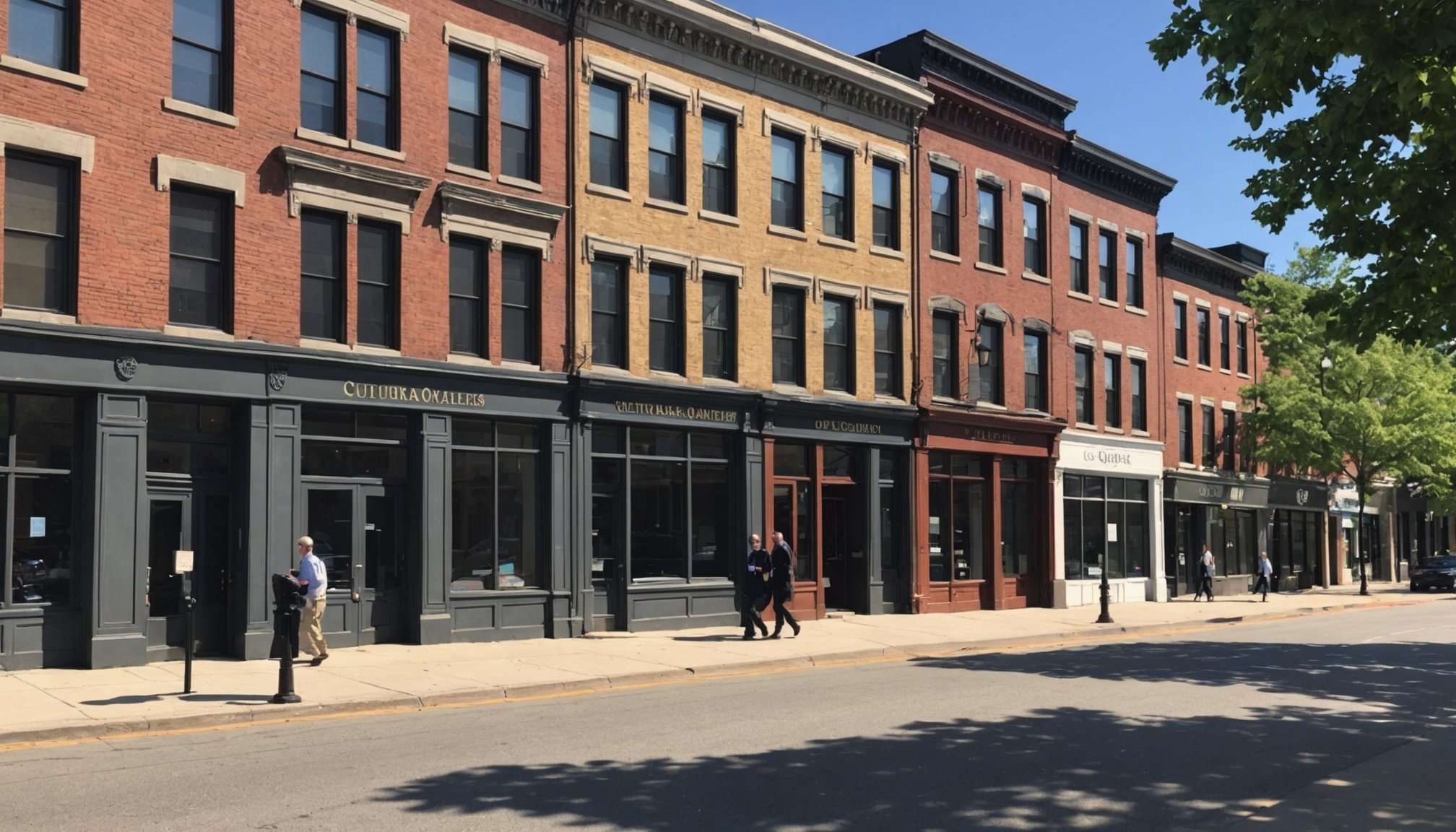Overview of Cultural Quarters and Their Significance
Cultural quarters are distinct urban areas that blend economic growth with cultural expression. These zones house cultural institutions—such as art galleries, theatres, and museums—and promote artistic activities. Their aim is to create hubs of creativity that energise and modernise city landscapes.
Historically, cultural quarters have surged in popularity due to their capacity to enrich cultural identity within urban settings. Initially emerging in response to industrial decline in the latter half of the 20th century, these areas have evolved as central to urban planning efforts. They catalyse not only physical but also socio-economic transformations, often positioning cities competitively on global cultural maps.
Topic to read : Unlocking Property Potential: A Deep Dive into Urban Green Spaces and Their Value Impact
The importance of cultural identity is crucial in shaping urban areas. It serves as a catalyst for city development by enabling cities to retain their historical essence while ushering in economic innovation. Crafting a vibrant cultural narrative can attract tourism, foster local pride, and stimulate economic growth. By integrating cultural quarters into city planning, urban policymakers can help create dynamic environments that thrive socially and economically.
Thus, adopting cultural quarters positively influences not just the community’s cultural wealth but also bolsters financial and structural advancements in urban areas.
This might interest you : Unlocking Potential: Pioneering Approaches to Housing Development on UK’s Brownfield Sites
Economic Implications of Cultural Quarters on Property Values
The presence of cultural quarters profoundly affects property values. Statistical analyses demonstrate a clear link between these vibrant areas and increased real estate prices. For instance, in cities like Liverpool and Glasgow, the establishment of cultural districts has led to property value surges of up to 15-20% within adjacent neighbourhoods. Such data highlights the positive financial impact generated by cultural amenities and artistic hubs.
Case studies provide insight into how cultural quarters drive economic change. In London’s Shoreditch, the integration of galleries and theatres has not only enriched the locality culturally but also pushed residential and commercial property prices upwards. Similarly, in Montreal, the Quartier des Spectacles is a focal point for cultural engagement that continues enhancing property markets. These examples illustrate the transformative benefits cultural hubs can foster.
Market trends are also intriguing, as they often reveal a ripple effect. Regions with planned cultural quarters frequently witness increased investor interest and heightened property demand. As cultural quarters become integral to urban development, understanding their economic implications is crucial for city planners and investors alike, enabling informed decisions that balance cultural enrichment with financial viability.
Role of Cultural Amenities in Urban Development
Cultural amenities are integral to fostering vibrant urban development and enhancing community engagement. These cultural amenities—such as theatres, museums, and galleries—transform neighbourhoods by creating accessible spaces that encourage artistic expression and community interaction.
A diverse array of cultural amenities can reinvigorate underutilised urban spaces, offering residents venues for creativity and socialization. This transformation often serves as a linchpin for urban revitalization, sparking renewed interest in areas previously considered economically stagnant. By incorporating artistic hubs into urban landscapes, cities can attract tourists while also enriching residents’ quality of life, thereby creating a positive feedback loop of ongoing development.
To increase community engagement in cultural projects, cities can implement strategic initiatives involving local artists and residents, fostering a sense of ownership and belonging. Workshops, festivals, and public art installations provide avenues for active participation, reinforcing the cultural fabric of the area.
The correlation between cultural investment and urban revitalization is well-documented. Investment in cultural amenities can lead to increased property values, attracting businesses and investors. As a result, areas with a robust cultural presence often experience economic growth, contributing to the attractiveness and competitive edge of cities on a global scale.
Expert Opinions and Analysis on Cultural Quarters
Unlocking the potential of cultural quarters is a multifaceted task, requiring expert analysis from urban planners and real estate professionals. These expert insights reveal best practices for integrating cultural zones into cityscapes, balancing vibrancy and economic growth. According to many professionals, effective urban policy must prioritize the holistic benefits of cultural quarters, considering ideas that go beyond mere economic implication.
Planners like Jane Jacobs advocate for fostering community engagement alongside cultural development. In her view, vibrant public spaces encourage interaction and contribute significantly to urban renewal. Moreover, real estate experts emphasize that successful cultural quarters maintain a symbiotic relationship between cultural authenticity and innovative developments to retain their urban vitality.
Looking towards the future, planners suggest several strategies for effective integration. Identifying pivotal cultural themes can guide area-specific artistic projects, while strong collaborations between public and private sectors ensure sustained economic growth. Urban policy must remain adaptive, embracing evolving cultural trends to enhance both city and investor outcomes. As cultural quarters influence urban policy, it becomes imperative to engage with these best practices, ensuring cities leverage their cultural identities for long-term development.
Case Studies of Cities Embracing Cultural Quarters
Exploring the development of cultural quarters in real urban settings offers invaluable insights into their transformative impact, especially on property values. By examining the experiences of successful cities, we can identify what works best and apply these learnings broadly.
City A: Overview and Financial Outcomes
In City A, the inception of a dynamic cultural quarter led to an impressive uptick in property values. Statistical analyses showed increases ranging from 10% to 25% within surrounding neighbourhoods. This surge was largely attributed to the area becoming a cultural and economic magnet. Additionally, community feedback has been overwhelmingly positive, with residents expressing increased pride in their urban environment.
City B: Comparison of Different Approaches
City B adopted varied strategies, including public-private partnerships that bolstered cultural and economic growth. These initiatives resulted in a moderate 5-15% rise in property values. Policy decisions, such as tax incentives for cultural businesses, played a crucial role in this outcome, highlighting the need for tailored approaches.
City C: Lessons Learned and Best Practices
Through its trials, City C discovered several best practices. It found that sustainable development combined with cultural investments can effectively enhance property values. Key recommendations include fostering robust stakeholder collaboration and maintaining cultural authenticity to ensure enduring success.
Recommendations for Stakeholders and Investors
Investing in cultural districts presents promising opportunities, given their rising influence on urban landscapes. Potential investors are encouraged to explore investment opportunities that capitalise on the co-existence of culture and economic growth. Here are several strategies to consider:
-
Diversification: Allocate resources to a mix of residential, commercial, and cultural spaces. This balance helps mitigate risks and promotes sustainable returns.
-
Engagement with Local Artists: Foster partnerships with local artists to create unique cultural experiences. These collaborations can differentiate properties and attract tourists and residents.
Policy recommendations for further enhancing cultural quarter initiatives are essential for their sustained success. Governments can implement supportive policies like tax incentives for cultural enterprises or infrastructure investments to augment the area’s attractiveness. Aligning policy goals with cultural enrichment ensures a productive partnership between sectors.
For a long-term investment outlook, stakeholders must remain adaptable to evolving trends, such as shifts in cultural consumption patterns and technological advancements. Informed decisions based on current trends and data are crucial in securing a competitive edge. By prioritizing cultural enrichment, stakeholders can bolster both cultural identity and economic viability.





